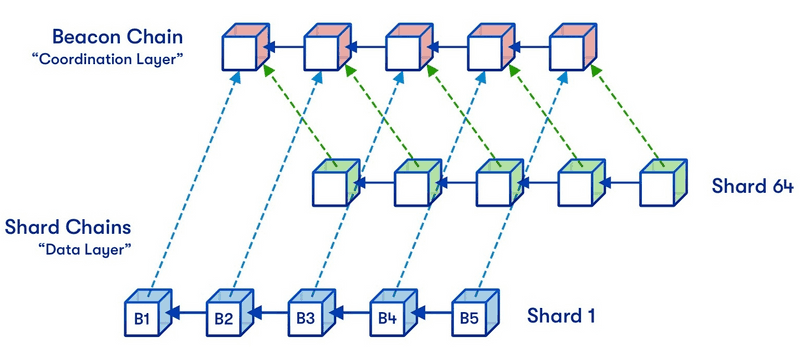The various highly anticipated updates to the Ethereum network are slowly but surely coming along. Last year we saw the deployment of the staking deposit contract, which successfully launched the beacon chain.
Proof-of-stake is one of the most impactful updates to Ethereum, aiming to make the network more sustainable and scalable while still being secure. Since launching in December 2020, the beacon chain has been able to run in parallel to Ethereum. While the Ethereum chain is still using proof-of-work, the beacon chain has successfully been using the proof-of-stake protocol.
The next anticipated ETH2.0 update will be "the merge," in which the Ethereum network as we know it will "merge" with the beacon chain, thus becoming its own shard that uses proof-of-stake. This will be a massive step towards scalability, but what will change exactly? And what are the next steps for ETH2.0?

Keep in mind that you don't need to do anything with ETH you are already holding for these network upgrades. Beware of scammers stating otherwise.
Refresher on the beacon chain
December 1st, 2020, saw the successful launch of the beacon chain, and has been working in parallel to Ethereum ever since. While the beacon chain hasn't enabled much else thus far, it's an integral part of the ETH2.0 upgrade.
The beacon chain is what coordinates the various shards that will at some point in the future be part of the network. People can stake their ETH and become a validator, which will allow them to process transactions and create new blocks. This process will no longer be done through mining (proof-of-work), causing an easier entry-level to contribute and secure the network.
The beacon chain will randomly assign validators to different shards which they will need to work on, which will make it effectively impossible to attack a specific shard. If a validator tries to attack the network they might lose their staked ETH, greatly disincentivizing such behaviour. Besides coordinating the validators on the network, the beacon chain also acts as a communication layer, allowing shards to exchange information with each other.
You can start staking with Ethereum right now by becoming a validator and contributing to the security of the beacon chain. We wrote a more in-depth article about the pros and cons of staking earlier, which you can find here.
The merge
The merge, formerly also referred to as "the docking," is what will cause the Ethereum chain that we know to transition to proof-of-stake. It's when the beacon chain and Ethereum mainnet will come together, with validators now securing the network instead of miners.
The Ethereum chain will become its own shard, controlled by the already-deployed beacon chain, and secured by validators instead of miners, ultimately resulting in the network becoming much more sustainable.
It was initially planned for shards to be implemented first, after which the merge would occur. However, it has since been decided that the merge will precede the roll out of shard chains, which will cause Ethereum to move to proof-of-stake earlier than initially planned.
Sharding
Sharding will introduce multiple blockchains to the network, to a total of 64 chains when launched. Sharding is not a new concept, and is commonly used in databases to split data up in chunks, so as to spread data and load. In Ethereum, its goal will be to improve scalability, reducing congestion on the network and allowing more transactions per second to be executed.
This method is needed to scale Ethereum in a decentralized manner, as an alternative would be to increase the size of the already existing chain, resulting in even more powerful computers being needed to process the network.
By letting validators only "focus" on one shard at once, and not the entire network (which is how it works at this time), less computational power is needed and a lower barrier of entrance is achieved, effectively allowing anyone to participate in securing the network and earning rewards on their stake. This is beneficial as more people will be able to participate, resulting in more decentralization of the network, and thus creating a much smaller attack surface.

Sharding will likely be split up in two phases: the first one providing the functionality to store extra data, and the second phase adding functionality to perform code execution through eWASM. The second phase is still being discussed within the community, though, as even the first phase might be enough to achieve the desired level of scalability.
While we're not quite there just yet, the merge is scheduled to happen either in 2021 or 2022. It will finally see the implementation of proof-of-stake to the Ethereum network, resulting in a more eco-friendly decentralized platform, with much more room to scale.
Even once the merge is completed, it won't signal the end of scheduled ETH2 upgrades just yet. After the merge, another upgrade will include the sharding implementation, and will bring the full 64 shards to the network, of which the Ethereum network as we know it today will already be one of after the merge.
With all these exciting upgrades coming soon to a blockchain near you, it's important to keep in mind that not all decisions are set in stone, and details might change with more research being done, and debates within the community being had. However, it's clear that ETH2.0 is what ultimately will make Ethereum more scalable and secure, while remaining decentralized.